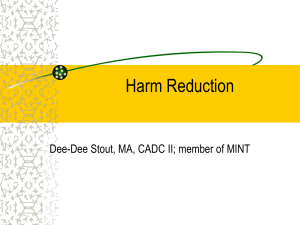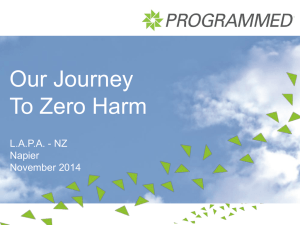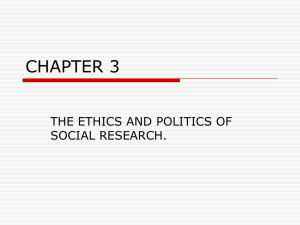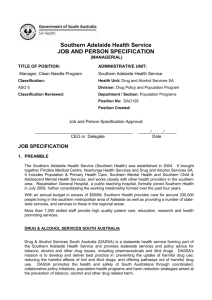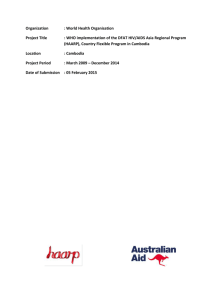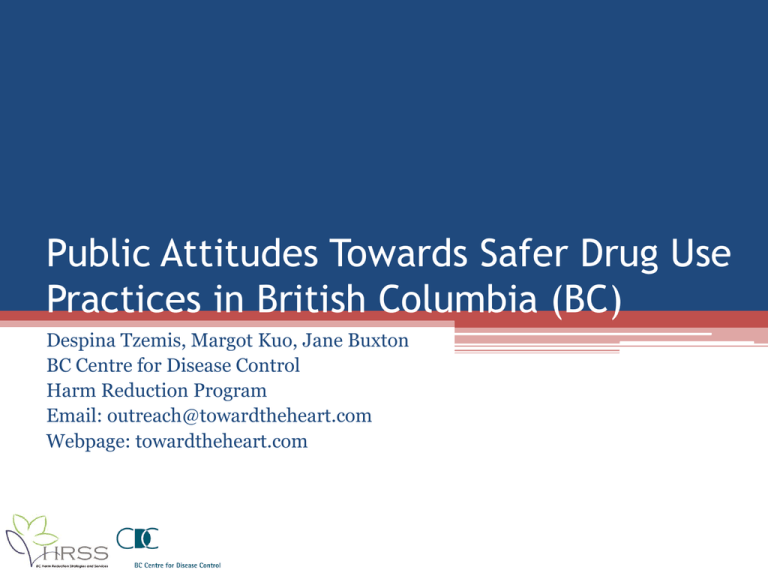
Public Attitudes Towards Safer Drug Use
Practices in British Columbia (BC)
Despina Tzemis, Margot Kuo, Jane Buxton
BC Centre for Disease Control
Harm Reduction Program
Email: outreach@towardtheheart.com
Webpage: towardtheheart.com
Outline
•
•
•
•
•
•
•
Who we are
Background
Objective
Methods
Results
Discussion
Conclusion
BC Harm Reduction Program
• BC CDC coordinates the BC HRSS and DOAP Committee.
• Committee: ministry of health , health authorities, first nations
input, & people who use drugs, among other stakeholders.
• Develop evidence-based policies, training resources, & distribute
supplies to reduce drug related harms.
• Continually evaluate program and identify areas of concern &
research - public attitudes toward harm reduction.
www.towardtheheart.com
Background
• The media and vocal opponents often negatively
represent safer drug use initiatives based on ideology,
not evidence
Background
• Media can influence policy, and so can public opinion.
(Boyd & Carter, 2010; MacNeil & Pauly, 2010)
• Policies:
▫ Represent the public’s views
▫ Should be evidence based
▫ Need to reduce harms
Objectives
• To better understand the British Columbian’s attitudes
toward harm reduction strategies and services
• Areas of interest:
▫
▫
▫
▫
harm reduction (general)
needle distribution
needle distribution in your community
safer inhalation equipment
Methods
• August 2011 conducted survey by random digit dialing.
• Socio-demographic information collected: sex, age, education
level, & residing geographic location.
• Questions: general harm reduction, needle distribution, &
safer inhalation equipment distribution.
• 2000 completed surveys.
• Statistical methods: weighted variable, multivariate logistic
regression
Results
• Our sample (n=2000):
▫ 50% female
▫ 3 age groups:
(28%) 19-34 years
(37%) 35-54 years
(35%) 55+ years
▫ Education:
(7%) >high school
(30%) completed university
▫ Region:
20% of respondents from each HA
90
80
(78%)
Do you
support harm
reduction?
70
60
50
40
30
(22%)
20
10
0
Support
Oppose
80
(75%)
Do you support
needle
distribution?
70
60
50
40
(25%)
30
20
10
0
Support
Oppose
80
70
(68%)
60
50
40
Do you support
needle in your
community?
(32%)
30
20
10
0
Support
Oppose
56
54
(54%)
52
50
48
Do you
support safer
inhalation
distribution?
(46%)
46
44
42
Support
Oppose
Harm Reduction bivariate (n=1749)
Variables
Support
n=1372
Oppose
N=377
p-value
Age
19 – 34
35 – 54
55+
396 (83.0%)
524 (80.1%)
452 (73.1%)
81(17.0%)
130 (19.9%)
166 (26.9%)
<0.001
Gender n (%)
Female
Male
712 (80.6%)
659 (76.2%)
171 (19.4%)
206 (23.8%)
Education n (%)
< high school
= high school
= some post secondary
= cert/diploma
= University
79 (68.1%)
251 (76.3%)
243 (79.4%)
356 (76.9%)
443 (82.8%)
37 (31.9%)
78 (23.7%)
63 (20.6%)
107 (23.1%)
92 (17.2%)
0.005
Health Authority n (%)
VCH
IH
FH
VIHA
NH
378 (82.2%)
229 (83.3%)
431 (71.5%)
249 (81.4%)
85 (81.7%)
82 (17.8%)
46 (16.7%)
172 (28.5%)
57 (18.6%)
19 (18.3%)
<0.001
0.024
Harm Reduction multivariate (n=1749)
Variable
OR
95%CI
AOR
95%CI
p-value
Age
19-34 (referent)
35-54
55+
0.83
0.56,
0.61, 1.12
0.41, 0.75
0.80 0.59, 1.10
0.54 0.40, 0.73
Sex
F (referent) vs M
0.77
0.61, 0.97
0.74
0.58, 0.93
0.011
Education
=University (referent)
<high school
=high school
=some post secondary
=cert/ diploma
0.45 0.28, 0.70
0.67 0.48, 0.94
0.80 0.56, 1.14
0.69 0.59, 0.94
0.46
0.77
0.86
0.69
0.29, 0.73
0.54, 1.08
0.60, 1.23
0.50, 0.95
0.001
0.132
0.400
0.022
Health Authority
VCH (referent)
IH
FH
VIHA
NH
1.07
0.54
0.95
0.99
1.19
0.56
1.06
1.10
0.79, 1.77
0.41, 0.75
0.73, 1.55
0.63, 1.94
0.407
<0.001
0.755
0.741
0.72, 1.59
0.41, 0.73
0.62, 1.38
0.57, 1.72
0.165
<0.001
Discussion
• High support for safer drug use practices
• Trends predictive of previous findings
• Targeted knowledge exchange
• Limitation: negative media re glass stem
distribution
Conclusion
BC supports Harm Reduction!
Harm Reduction works!
Policies should reflect this!
Reference
• Boyd, S. & Carter, C. (2010). Methamphetamine Discourse: Media,
Law, and Policy. Canadian Journal of Communication, 35: 219-237.
• MacNeil, J. & Pauly, B. (2010). Impact: a case study examining the
closure of a large urban fixed site needle exchange in Canada. Harm
Reduction Journal, 7:11.
Acknowledgment
• HR service providers and health care providers
across BC for the work they do
• People who use drugs and community members
for advocating for safer drug use policies
Thank you!
• Questions?
• Contact information:
despina.tzemis@bccdc.ca
Webpage: www.towardtheheart.com



